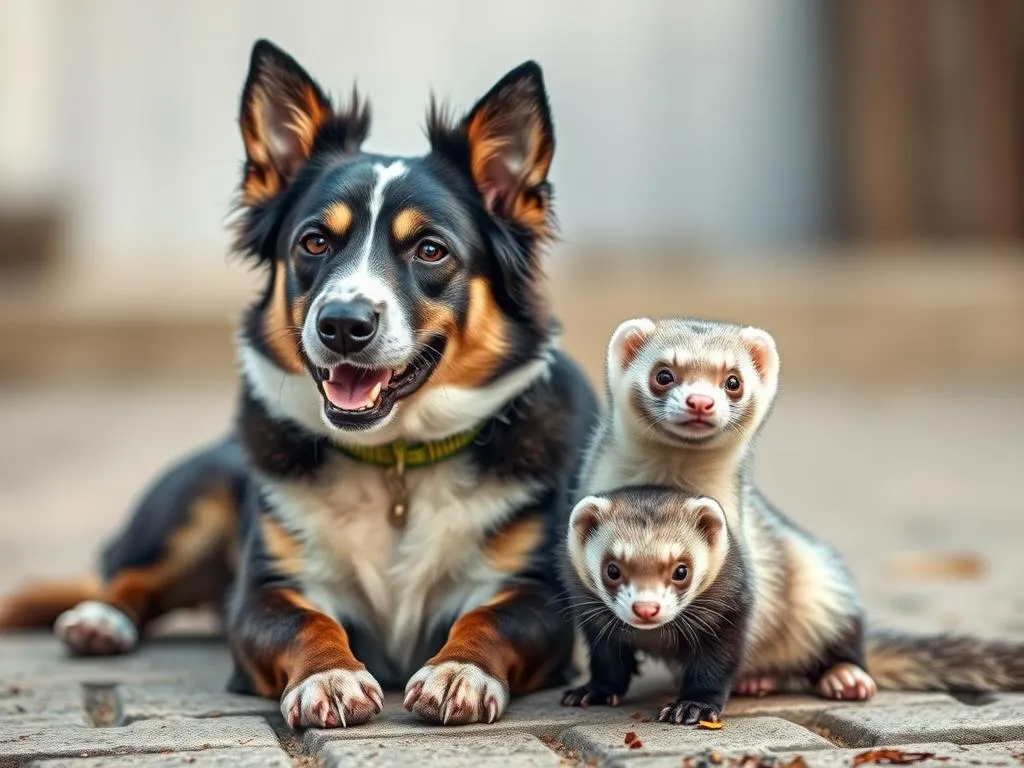
Introduction
Understanding interspecies relationships is crucial for pet owners who wish to create a harmonious home environment. Among the many pairings of household pets, the question of whether dogs and ferrets get along often arises. Both animals possess unique characteristics that can influence their interactions. While dogs are known for their loyalty and pack mentality, ferrets are playful and curious creatures. This article aims to explore the compatibility between these two species and provide insights and practical tips for pet owners looking to foster an amicable relationship between their dogs and ferrets.
Understanding Dog and Ferret Behaviors
Canine Behavior
To comprehend the dynamics between dogs and ferrets, it’s essential first to understand typical dog behaviors. Dogs are social animals that thrive on companionship and often exhibit a pack mentality. They communicate through vocalizations, body language, and scent marking. Their interactions with other animals are heavily influenced by their breed traits, upbringing, and individual experiences. Friendly breeds, such as Golden Retrievers and Labrador Retrievers, tend to be more accommodating of other pets, while breeds with high prey drives may pose challenges when introduced to smaller animals like ferrets.
Ferret Behavior
Ferrets, on the other hand, are inherently playful and curious. They are known for their energetic nature and love for exploration. Ferrets communicate through a series of body language cues and vocalizations, such as chattering and dooking. Understanding their social behavior is vital; ferrets are social animals that thrive in groups, and they often display strong playfulness and curiosity towards other animals. This playful nature can sometimes lead to misunderstandings in interactions with dogs.
Differences in Communication
Communication styles between dogs and ferrets are quite different. Dogs often use barks, growls, and body posture to express their feelings, while ferrets rely heavily on body movements and soft vocalizations. Understanding these differences is key to interpreting their interactions. For instance, a dog wagging its tail may indicate friendliness, while a ferret approaching with a wiggly body may be seeking play. Being aware of these signals can help pet owners gauge the comfort level of both animals during interactions.
Factors Influencing Compatibility
Breed-Specific Traits
When considering whether dogs and ferrets get along, breed-specific traits play a significant role. Some dog breeds are known for their friendliness and adaptability, while others may exhibit more aggressive or predatory behaviors. For example, herding breeds like Border Collies may see ferrets as potential prey due to their quick movements. Conversely, breeds such as Beagles and Cavalier King Charles Spaniels typically have a gentler disposition and may be more accepting of ferrets. Ferrets themselves also vary in temperament; some are more laid-back, while others can be assertive.
Individual Personalities
Just like humans, animals have unique personalities that can greatly influence their interactions. A friendly and calm dog may get along well with a playful ferret, while a timid or aggressive dog could pose a threat to a ferret. Individual cases often provide insight; for instance, a dog raised with ferrets from a young age is likely to be more tolerant than one introduced to ferrets later in life. Observing individual personalities can help pet owners predict the outcome of introducing a dog and a ferret to each other.
Early Socialization and Training
The importance of early socialization cannot be overstated when it comes to ensuring that dogs and ferrets get along. Dogs that are exposed to various animals during their critical development period are more likely to accept new friends, including ferrets. Similarly, ferrets that have interacted with dogs early on may be less fearful and more inclined to play. Training is equally important; teaching dogs commands such as “leave it” or “gentle” can help manage their behavior around ferrets.
Signs of Compatibility
Positive Interactions
One of the best indicators that dogs and ferrets get along is their ability to engage in positive interactions. Friendly behaviors can include curious sniffing, gentle play, and relaxed body postures. Supervising playtime is crucial; it allows pet owners to step in if necessary, ensuring both animals feel safe and comfortable. Engaging in supervised play also gives owners the opportunity to reinforce positive behaviors with praise or treats.
Mutual Respect
Recognizing signs of mutual respect is another key factor in determining compatibility. For example, if the dog allows the ferret to approach without showing signs of aggression, or if the ferret respects the dog’s space, it indicates a level of comfort between the two. Understanding boundaries is essential; teaching both pets to respect each other’s personal space can lead to a more harmonious coexistence.
Potential Challenges
Prey Drive in Dogs
One of the most significant challenges in ensuring that dogs and ferrets get along is the prey drive that some dogs possess. Prey drive refers to an instinctual inclination to chase and capture smaller animals. This instinct can pose serious risks for ferrets. Managing a dog’s prey drive involves consistent training and supervision. For instance, keeping the ferret in a secure enclosure during introductions can help mitigate risks. Understanding a dog’s breed tendencies is crucial; breeds known for high prey drive, such as Greyhounds or Terriers, may require more careful management.
Territorial Behavior
Territorial instincts can also affect interactions between dogs and ferrets. Dogs often consider their home as their territory, and introducing a new animal can lead to defensive behavior. To create a peaceful coexistence, it’s essential to manage territorial behavior. This can be achieved by designating separate spaces for each pet and allowing them to become accustomed to each other’s smells and presence before direct introductions.
Health and Safety Concerns
Health and safety should always be a priority when considering whether dogs and ferrets get along. Introducing two different species can pose health risks, such as the transmission of parasites or diseases. Ensuring both pets are up-to-date on vaccinations and parasite control is vital. Additionally, pet owners should be aware of any potential hazards in their home environment, such as objects that could be harmful to either animal.
Tips for Successful Introductions
Preparing the Environment
Setting up a safe environment is essential for a successful introduction. Both animals should have designated safe spaces where they can retreat if they feel overwhelmed. Creating a neutral territory for the first meeting can also help reduce anxiety and territorial behavior. This might be a room that neither pet considers their own, allowing them to explore each other’s presence without feeling threatened.
Gradual Introductions
Introducing dogs and ferrets should be a gradual process. Start by allowing them to sniff each other’s bedding or toys to familiarize themselves with each other’s scent. When they seem comfortable, you can proceed to face-to-face introductions. Begin with the dog on a leash, allowing the ferret to explore at its own pace. Patience is vital; take your time and observe their reactions closely, stepping in if necessary.
Ongoing Monitoring
After the initial introductions, ongoing monitoring is crucial to ensure the safety and comfort of both pets. Look for signs of stress or aggression, such as growling or hissing. Regularly supervise their interactions, especially during playtime. If any negative behaviors arise, it may be necessary to separate them temporarily and reassess the introduction process.
Conclusion
In summary, exploring whether dogs and ferrets get along requires an understanding of their behaviors, individual personalities, and the factors that influence compatibility. By recognizing the differences in communication styles, managing challenges such as prey drive and territorial behavior, and employing effective introduction strategies, pet owners can foster a peaceful coexistence between these two species.
Responsible pet ownership involves researching and understanding the needs of both dogs and ferrets, ensuring that their environments are safe and conducive to their well-being. With patience, observation, and care, it is indeed possible for dogs and ferrets to build a harmonious relationship that enriches the lives of both pets and their owners.









